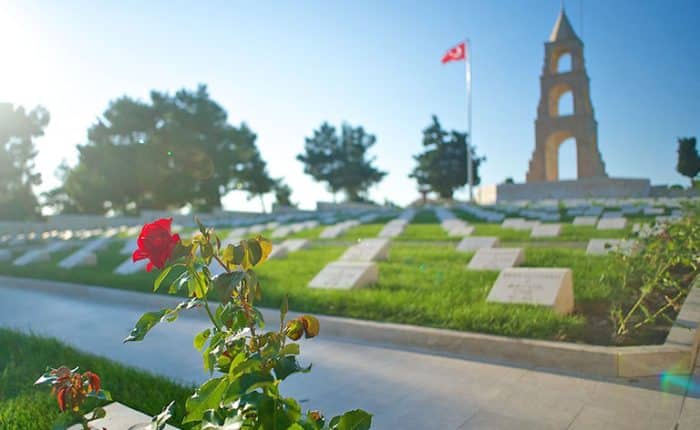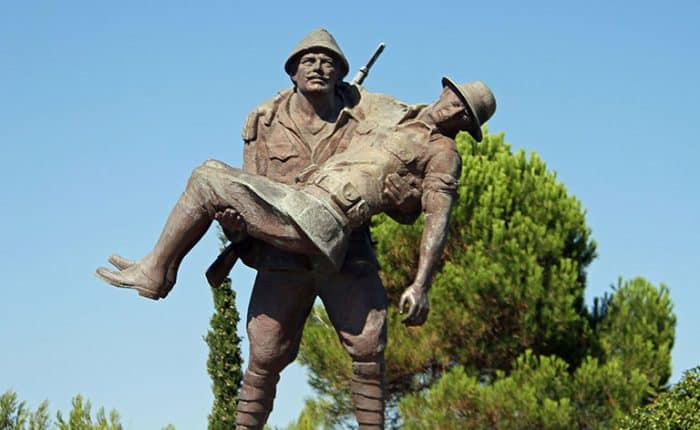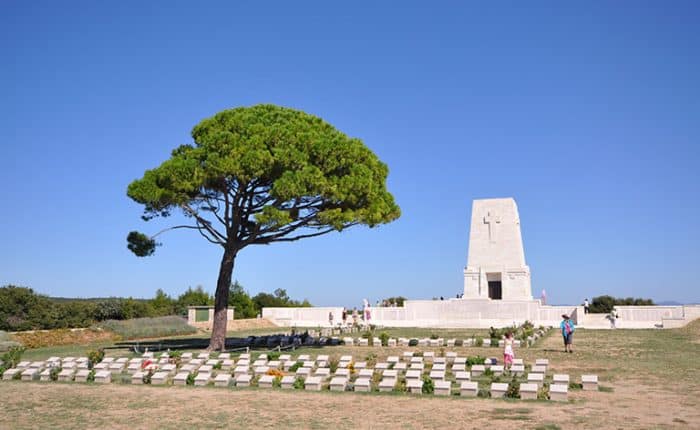Did you know that the Dardanelles strait is named after Dardanos- the mythological ancestor of the Trojans? It divides the European and Asian sides of Turkey, and under the Greeks, it was known as Hellespont, meaning ‘Sea of Helle.’ It’s here that the Persian King Xerxes I crossed over using a pontoon bridge on his way to invade Greece in 480 BCE. Another famous crossing was made by Alexander the Great when he visited Troy in 334 BCE.
And speaking of Troy, Gallipoli Peninsula has been occupied from as far back as 4000 BCE, during the bronze age. The ancient settlements discovered here have levels from Troy I to Troy IV with subdivisions. According to Greek authors, the Trojan War played out here somewhere between the 13th and 12th centuries BCE before culminating in the infamous stroke of genius that is the Trojan horse.
This wouldn’t be the last famous war/battle on the peninsula. Over 30 centuries later, when the world had moved far beyond swords and spears to guns and artillery, Gallipoli saw another battle between the Allied forces and the Ottoman Empire. This was the Gallipoli Campaign, and it set the stage for an unknown lieutenant to prove his brilliance and eventually lead the Turkish Republic from the ashes of the Ottoman Empire.
It takes about a full day or two to explore the best of the peninsula. So, if you’re visiting Gelibolu independently, make arrangements for your accommodation in the neighboring towns before your arrival. Your best bet would be to book a hotel room in Canakkale or Eceabeat in the south of the peninsula; Gelibolu town on the peninsula’s northern end is too far away for a convenient tour.
Alternatively, you can book a guided tour of the battlefields. Depending on the package, this frees you of the responsibility of transport and seeking accommodation. You’ll also enjoy an itinerary designed to give you an outstanding educational experience on the peninsula’s best attractions.
Gallipoli has a Mediterranean climate, meaning its winters are mild and summers are hot and dry. The hottest months are August, July, and June and are best for those looking to enjoy some summer beach time during their visit.
September to November is also a good time to visit the peninsula. The temperatures range between 37℉ and 86℉ while the humidity stands at 79%, creating the perfect climate for a day-long exploration of Gallipoli.
December and January typically have colder temperatures. Thus, they are not popular times to visit the peninsula.
A commemorative service is held on April the 25th every year. This is known as Anzac Day, a day when tourists, war veterans, and Government officials converge at the peninsula to remember the lives lost in the campaign.
If visiting daily from Istanbul, it is better to have a late breakfast/early lunch at Gallipoli town center. If already in Canakkale, there are still facilities serving local food around the national park.
Gallipoli is a vast national park. If you want to explore it entirely, you want to stay in the area for at least one full day.
The national park is open all year round with no entrance fee, and museums are available to visit between 08:00 and 17:00.
However, it’s important to note that alcohol is banned at all cemeteries and memorials.



The Gallipoli Peninsula stands as an enduring memorial to the horrors of war and the bravery they forced out of the men involved. Thus in 1973, the Turkish government established the Gelibolu Penisula Historical National Park to honor the 500,000 soldiers who lost their lives during the World War I Gallipoli Campaign.
If you have any knowledge of military history, you can pretty much tell why the area has been so hotly contested in history; the Dardanelles strait. It is a strategic waterway that was vital to the success or failure of military campaigns in the region.
For Instance, the Persians needed to cross the strait before they could conquer Greek. Had they failed to do so, the fate of the ancient world and the course of history would have been changed forever.
Imagine hundreds of boats floating across the strait as you stand on Hellenspot and look upon the waters. These boats would act as the base of a bridge that would carry 300,000 men and thousands of horses to where you’re standing. Only then will you appreciate the scale of this achievement.
While at it, take time to appreciate the beauty of the lands sprawled before you and the waters below. Gallipoli may have a tumultuous past, but time has transformed it into a stunning location with beautiful beaches, bays, and an interesting variety of plant life. There is also a salt lake and several geological and geomorphic structures worth a visit.
However, the actual tour begins with the exploration of the memorials of the national park. There are around 37 Turkish memorials, epitaphs, and cemeteries in the peninsula, and a further 33 belong to France, New Zealand, Britain, and Australia. These include:
Martyrs Memorial: Erected in honor of the Turkish soldiers who lost their lives during the campaign. It’s part of a larger complex with a museum of war materials and a symbolic cemetery at the entrance.
Cape Helles Memorial: Erected in honor of 29,761 Australian, British, and Indian soldiers who were never found after the campaign’s battles.
French Cemetery and Memorial: Built on a hill dominating Morto Bay, the memorial was erected to honor 14,382 French and African soldiers who fell during the battles.
Lone Pine Memorial and Cemetery: Erected in honor of the New Zealand and Australian soldiers who died in the battles at Anzac.
New Zealand National Memorial and Cemetry: Erected on the crest of Conkbayiri to honor New Zealand soldiers lost in the campaign.
Ari Burcu Cemetery: This was one of the original cemeteries dug during the battles of 1915. It gets its name from the cape on the Northern side of Anzac Cove.
If you have booked the 2-day Troy & Gallipoli tour with us, you’ll also get to visit the historical site of Troy, where archeological work has revealed nine separate periods of settlement. Nothing much stands on the site, but the chance to walk the ground of the legendary Battle of Troy is an exciting opportunity. There is also a wooden representation of the Trojan horse, which the Greeks used as a means to breach the walls of Troy and win the war from the inside.
If you have time, you’ll want to visit the following attractions in the region: Edirne, Bursa, Tekirdag, or down to the west, visiting Troy, Pergamon, Assos, etc.